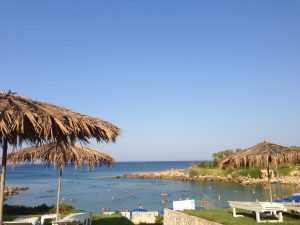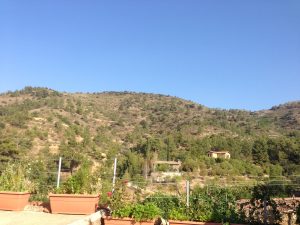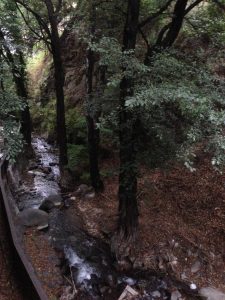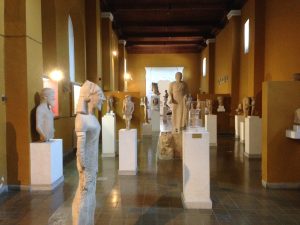Cyprus, nestling in the Eastern Mediterranean, is said to be the birthplace of Aphrodite, the famous Greek goddess of love. This can go some way towards explaining why those who visit this island find themselves in love with the incredible hospitality that complements its history and natural beauty.
Beaches, mountains, traditional villages, ancient history, year round sunshine and great food are just some of the many reasons that Aphrodite’s island will seduce you with its charms. And leave you wanting to come back for more!
Beautiful beaches
The sun-kissed beaches have always played a major role in Cyprus’ tourism. With so many blue flag designated beaches dotted along the coast to choose from, few islands can match Cyprus for those who like to escape to the sand.
Ayia Napa may have a bit of a sometimes infamous reputation of outrageous revelry, especially among Brits of the 18-30 demographic! Although that does not paint the full picture. There is still a great WaterWorld theme park for the kids and the quaint nearby fishing village still is a great place to explore in the daytime.
Protaras, a few kilometres to the north of Ayia Napa, is like the quiter, better dressed and better behaved sibling. Although it has seen its fair share of holiday village development as well, it has a much more laid-back family friendly feel. Perfect crystal clear blue waters make the nearby Fig Tree Bay an ideal spot for diving. Cape Greco nearby is just the place for exploring the forests.

Mountains and traditional villages
Located very much in the centre of the island, the Troodos mountain region is where you find many traditional Cypriot villages. And what really won me over was how well preserved and rich in social community these were.
Fikardou, an almost deserted settlement in the south of the mountains, feels like being in a time warp. Eerily quiet, save for the Yiannakos tavern, which serves as the community’s focal point of socialising. This village was awarded a “Europa Nostra” award in 1986 for preservation.

Kakopetria, in the heart of the Troodos, has an almost Alpine like charm. Taking its name from the legend of the cursed stones (Kakopetria translates as bad rocks) that brought bad luck to a newly married couple, this remains a very popular holiday getaway for locals. Peaceful and serene may seem like cliche words but a walk along the stream that flows down below puts you in contact with nature.

You would not normally associate Cyprus with skiing but you must think again. Mount Olympus, the islands highest point, has sufficient facilities for enthusiasts or just anyone who wants to build a snowman! And even so, whatever time of year this is an absolutely perfect region for hiking. Many monasteries of great significance are located in the Troodos mountains but perhaps the most famous is the Kykkos monastery. Located in the village of Pedoulas, this history of this monastery dates back to the early Byzantine period and is decorated with some of the most ornate golden colours inside. Moreover, on the outside walking along the balconies that overlook the courtyard you see some elaborate paintings dotted around.
Nicosia (Lefkosia)
The capital city and presently the world’s only divided city often gets unfairly overlooked by tourists. Sure you may not find any beaches right in the very center of Cyprus. But undoubtedly, Nicosia (or Lefkosia), as the cultural and financial capital, provides the best introduction to Cypriot life.
Of the numerous museums around, the Cyprus Museum is a great introduction to the island’s history. A superb place for an exhibition of the artefacts of ancient civilisation that made a mark on this island. Through each room is a focus on one of the many different periods of civilization in Cyprus. We start with the prehistoric findings then all the way up to Roman rule.

One of the more niche but brilliantly fascinating is the Cyprus Classic Motorcycle Museum, a collection of vintage motors that include various police escort bikes. The Leventis Museum is one of the most important museums on the island. Here, you find a wealth of items covering the history of Nicosia specifically from the Stone Age to the present.
Walking through the city centre and the bustling streets of Ledra and Onassagoru are the heart of the action. Not only is this the place for traditional Greek food but also a joy to watch traditional bouzouki players performing or the older generation enjoying a game of backgammon. A number of souvenir flea markets are located nearby as well and this area is very much the epicentre of nightlife and entertainment for young and old alike.
Ancient history
Of course, the fascinating history of Cyprus goes back as far as the Neolithic age, as seen in the Cyprus Museum. Across the island there are numerous locations of great archaeological significance. The Paphos Archaeological Park is almost like an ancient mini-city.
Halfway between Paphos and Limassol is the mythical Petra tou Romiou. Birthplace of Aphrodite (it is also known as Aphrodite’s Rock).

The ancient city of Kourion (near Limassol), is another archaeological site with an ancient amphitheater at the forefront. A centrepiece of theatre performances from the 2nd Century BC to around 2nd Century AD, it has been restored and in its open air ruins remains a popular location for cultural events during the summer months that re unmissable. What you also have in Korurion are the remains of an ancient city. The remains of the ancient baths, the church and the agora add to the mystique of the classics.
Natural wonders
Also, Cyprus is a perfect location for nature lovers most special of all the Akamas Peninsula near Paphos. A perfect location especially for those looking for an excursion that takes in biodiversity and nature. Come the end of the summer at Lara Bay the turtles hatch from their eggs and are an absolute joy to see swimming into the sea. And if you fancy getting closer you can always go diving into the sea and actually swim with the turtles.
But what is striking about the Akamas peninsula is how clear and blue the sea really is, noticeable from a great distance. An ideal natural wildlife habitat.

3 Responses
Erica
That water looks gorgeous! I’d love to snorkel there.
kasia
I have always wanted to visit Cyprus! It looks so gorgeous and seems to be a little under the radar (for now) which makes it even more appealing! Your pics confirm it 🙂
JOURNEYMAXX
Coastal cities like Paphos are always popular but Nicosia, for a capital, seems under the radar compared to most European capitals I think.